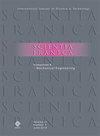Modeling of Jet Electrochemical Machining Using Numerical and Design of Experiments Methods
IF 1.9
4区 工程技术
Q2 ENGINEERING, MULTIDISCIPLINARY
引用次数: 0
Abstract
Modeling and determining the optimal conditions for the jet electrochemical machining (Jet-ECM) process is critical. In this study, a hybrid approach combining numerical and design of experiments (DOE) methods have been applied to model and determine the optimal conditions for Jet-ECM. The voltage (V), inner tool diameter (I), initial machining gap (G), and electrolyte conductivity (C) are considered input variables. Additionally, dimensional accuracy (E) and machining depth (D) are response variables. Twenty-seven numerical simulations have been performed using the Box–Behnken design to implement the response surface methodology (RSM). Consequently, two mathematical models have been obtained for these response variables. The effects of the input variables on the response variables are investigated using statistical techniques such as variance analysis. Furthermore, the desirability function approach has been applied to determine the optimal conditions for dimensional accuracy and depth of machining. The results show that the optimal values for achieving maximum depth of machining while maintaining a dimensional accuracy of 0.05 mm are as follows: electrolyte conductivity of 8 S/m, voltage of 36.9 V, initial machining gap of 200 μm, and inner tool diameter of 0.4 mm.射流电化学加工的数值模拟与实验设计方法
射流电化学加工(jet - ecm)过程的建模和优化条件的确定至关重要。本文采用数值与实验设计相结合的方法对射流- ecm的最佳条件进行建模和确定。电压(V)、刀具内径(I)、初始加工间隙(G)和电解液电导率(C)被认为是输入变量。另外,尺寸精度(E)和加工深度(D)是响应变量。采用Box-Behnken设计进行了27次数值模拟,以实现响应面法(RSM)。因此,得到了两个响应变量的数学模型。输入变量对响应变量的影响使用方差分析等统计技术进行研究。在此基础上,应用理想函数法确定了尺寸精度和加工深度的最佳条件。结果表明:在保持尺寸精度为0.05 mm的条件下,电解液电导率为8 S/m,电压为36.9 V,初始加工间隙为200 μm,刀具内直径为0.4 mm,可实现最大加工深度。
本文章由计算机程序翻译,如有差异,请以英文原文为准。
求助全文
约1分钟内获得全文
求助全文
来源期刊

Scientia Iranica
工程技术-工程:综合
CiteScore
2.90
自引率
7.10%
发文量
59
审稿时长
2 months
期刊介绍:
The objectives of Scientia Iranica are two-fold. The first is to provide a forum for the presentation of original works by scientists and engineers from around the world. The second is to open an effective channel to enhance the level of communication between scientists and engineers and the exchange of state-of-the-art research and ideas.
The scope of the journal is broad and multidisciplinary in technical sciences and engineering. It encompasses theoretical and experimental research. Specific areas include but not limited to chemistry, chemical engineering, civil engineering, control and computer engineering, electrical engineering, material, manufacturing and industrial management, mathematics, mechanical engineering, nuclear engineering, petroleum engineering, physics, nanotechnology.
 求助内容:
求助内容: 应助结果提醒方式:
应助结果提醒方式:


